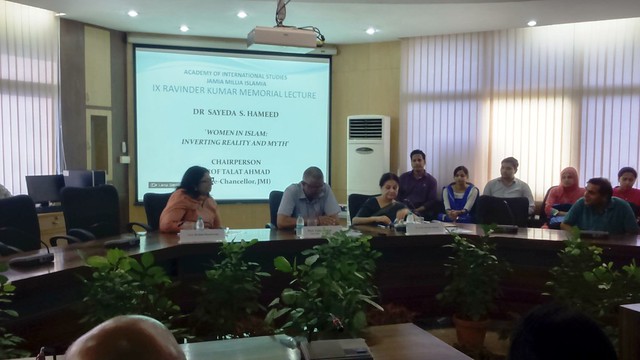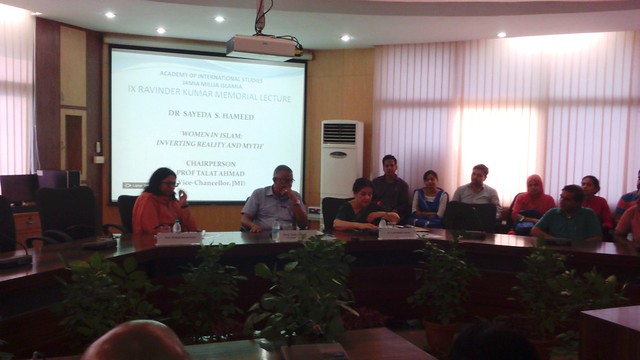By Manzar Imam for TwoCircles.net
New Delhi: It was a brainstorming session in which students raised serious questions about Islam in general and about Muslim women’s issues and the role of ulama in particular at Jamia Millia Islamia when women’s rights activist and educationist Dr Syeda Saiyidain Hameed tried to pull the answers apart by separating certain myths from realities.

Ravinder Kumar Lecture – Dr Hameed, to her right VC Prof. Talat Ahmad and Prof. Rashmi Doraiswamy
She was delivering the IXth Ravinder Kumar Memorial Lecture titled “Women in Islam: Inverting Reality and Myth” organised by the Academy of International Studies (AIS), JMI on Wednesday, October 5. The lecture was chaired by Vice-Chancellor Professor Talat Ahmad and moderated by Professor Rashmi Doraiswamy, Director, AIS.
Calling women in Islam the “hot topic” which you cannot escape when you look at the media today, the former member of the Planning Commission of India suggested that there was need to ‘segregate the myth from the reality’ because we are all “victims of that myth” and mostly relatively “ignorant of the details of the subject”. Placing the topic into a context, she said that the global image of the Muslim woman could be explained in 3 Bs and 3 Cs. The Bs are burqa, backward and beleaguered and the Cs are chulha, chakri and char-diwari; Indian words to define the role of women as being limited to cooking, doing other household chores and being confined to home.
Hameed said that there was a clear bias about hijab as was observed during a post-screening discussion of a beautiful film ‘Ujale Ki Ore’ made by an alumna of Jamia’s Mass Communication and Research Centre at a women’s college in Delhi.
What Islam has given to women is different from what is being portrayed in the media and practiced by Muslims, she asserted. She quoted a verse from the Quran (Verse 35 of Chapter 33) revealed in answer to a question raised by Umm Salama, one of the wives of Prophet Muhammad as to why only men were addressed in the Quran. Does it mean that women have a lesser status than men do? The verse clearly mentions women along with men for whom Allah announces forgiveness and great reward without distinction on account of gender which means that women in Islam have equal status to men.

Hameed demanded that any text must be understood in the context in which it is revealed. Elaborating that she said that laws pertaining inheritance and right of women in land for example should be viewed historically. At the time when the verses of inheritance were revealed women were completely deprived of any right. She said that Surah Al-Nisa (Chapter No 4 of the Quran meaning Women) gives detailed instructions about women’s rights with new provisions all to do with talaq, marriage, property rights. The order for the right of women in inheritance and property was like a bombshell as it deprived men of the old traditional privilege, she said adding that media had damaged the image of Muslim women. Many of the achievements and glories of Islam have been forgotten. “It is very convenient to stereotype Muslim women as meek and voiceless.”
It is important to understand that Islam was born in a context. It was meant to address the ills of an era called the Era of Jahiliyah that is an era of ignorance. The problem is that we Muslims hung on to each and every word without understanding the profound spirit behind the language. Despite Islam having everything, Muslims haven’t taken few strides. They have stood still.
Dr. Hameed held ulama accountable for failing to do their duty to spread awareness among Muslims about Islamic laws. She cited Maulana Abul Kalam Azad that deen (religion) was easy but we make it look difficult. We stopped reading and understanding the Quran. Instead of importing good things “We took from other cultures all the patriarchal values”, she said adding that there is “no dowry but dower” in Islam. This is how things have been inverted and we have wrong things like dowry. Many of these are open to critical explanation, she said hinting to the rigidity of some ulama.
While talking about the burning issue of triple talaq, Dr Hameed, also a former member of the National Commission for Women, said that issues like poverty cut across societies, but there’s a double whammy for the Muslim women as they are under the fear of the Domiciles’ sword of triple talaq.
Hameed also hit back at some of the arguments of the All India Muslim Personal Law Board given in support of triple talaq like if a man is not allowed to give talaq he would do more harm to the woman either by killing her, poisoning her or in other ways. She rejected them “ridiculous arguments” stating the position of some of the earlier leaders of the Board like Maulana Ali Miyan Nadwi and Qazi Mujahidul Islam Qasmi who had felt the need for serious reform among Muslims in matters of marriage, divorce, maintenance, etc. Ali Miyan had suggested that there was need for the orthodox ulama to “put Islam in the right ray” and speak against the prevalent wrong practices.
During the question and answer session one student summed up the dilemma while raising a question as from whom general Muslims were supposed to learn Islam because, on the one hand there were ulama who are corrupt and ignorant of the reality of the world and, on the other hand there were liberal Muslims who have no expertise and who try to explain Islam from sources which aren’t original. Sandwiched between the two extremes is the suffering common man confused as to what and what not to do.
Earlier, Professor Doraiswamy and Dr. Hameed paid tribute to Professor Ravinder Kumar remembering him as an incisive mind with a compelling personality.
The author is a PhD student at the Academy of International Studies, Jamia Millia Islamia

